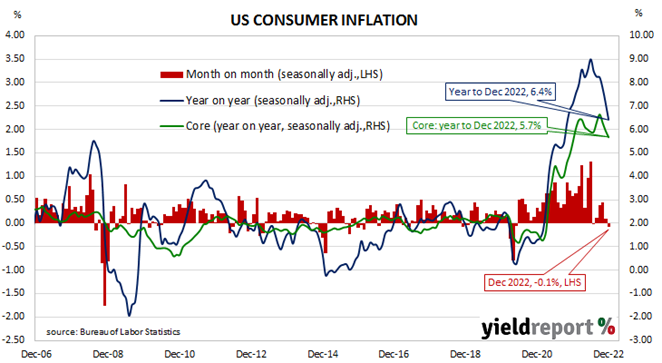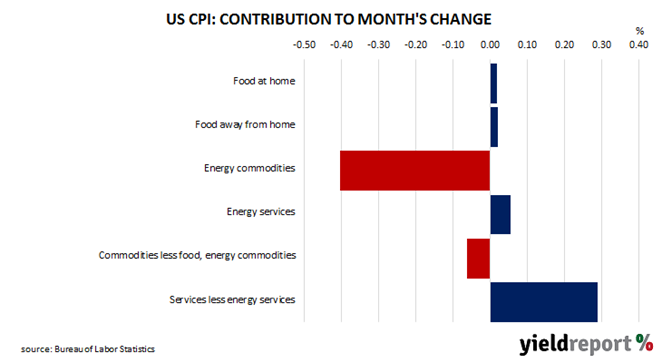Summary: US CPI down 0.1% in December, less than expected; “core” rate up 0.3%; inflation easing, expectations building for Fed easing in second half of 2023; Treasury yields fall considerably; rate-rise expectations soften; goods inflation “solved”, services inflation key for 2023; energy prices main driver, subtracts 0.41 ppts.
The annual rate of US inflation as measured by changes in the consumer price index (CPI) halved from nearly 3% in the period from July 2018 to February 2019. It then fluctuated in a range from 1.5% to 2.0% through 2019 before rising above 2.0% in the final months of that year. Substantially lower rates were reported from March 2020 to May 2020 and they remained below 2% until March 2021. Rates have since risen significantly.
The latest CPI figures released by the Bureau of Labor Statistics indicated seasonally-adjusted consumer prices declined by 0.1% on average in December. The result was less than the flat result which had been generally expected and it contrasted with November’s 0.1% increase. On a 12-month basis, the inflation rate slowed from 7.1% to 6.4%.
“Headline” inflation is known to be volatile and so references are often made to “core” inflation for analytical purposes. The core prices index, the index which excludes the more variable food and energy components, increased by 0.3% on a seasonally-adjusted basis for the month. The rise was in line with expectations and more than November’s 0.2%. The annual growth rate slowed from 6.0% to 5.7%.
“Overall inflation is easing in the US, with markets taking that as a sign that the Fed will be able to pause, and that as the economy starts to react to the monetary tightening put into place, the Fed will cut rates in H2 2023,” said NAB senior economist Tapas Strickland.
US Treasury bond yields finished considerably lower on the day. By the close of business, the 2-year Treasury yield had shed 8bps to 4.13%, the 10-year yield had lost 10bps to 3.44% while the 30-year yield finished 9bps lower at 3.58%.
In terms of US Fed policy, expectations of higher federal funds rates over the next 12 months softened. At the close of business, contracts implied the effective federal funds rate would average 4.595% in February, 27bps higher than the current spot rate, and then climb to an average of 4.66% in March 2023. May 2023 futures contracts implied a 4.89% average effective federal funds rate while December 2023 contracts implied 4.475%.
“The overall theme of the print is that goods inflation is now solved, but the evolution of services inflation will be the key for 2023,” said NAB senior interest rate strategist Ken Crompton.
The largest influence on headline results is often the change in fuel prices. Prices of “Energy commodities”, the segment which contains vehicle fuels, decreased by 9.4% and subtracted 0.41 percentage points from the index. Prices of non-energy services, the segment which includes actual and implied rents, had the next-largest effect on the total, adding 0.29 percentage points after increasing by 0.5% on average.



